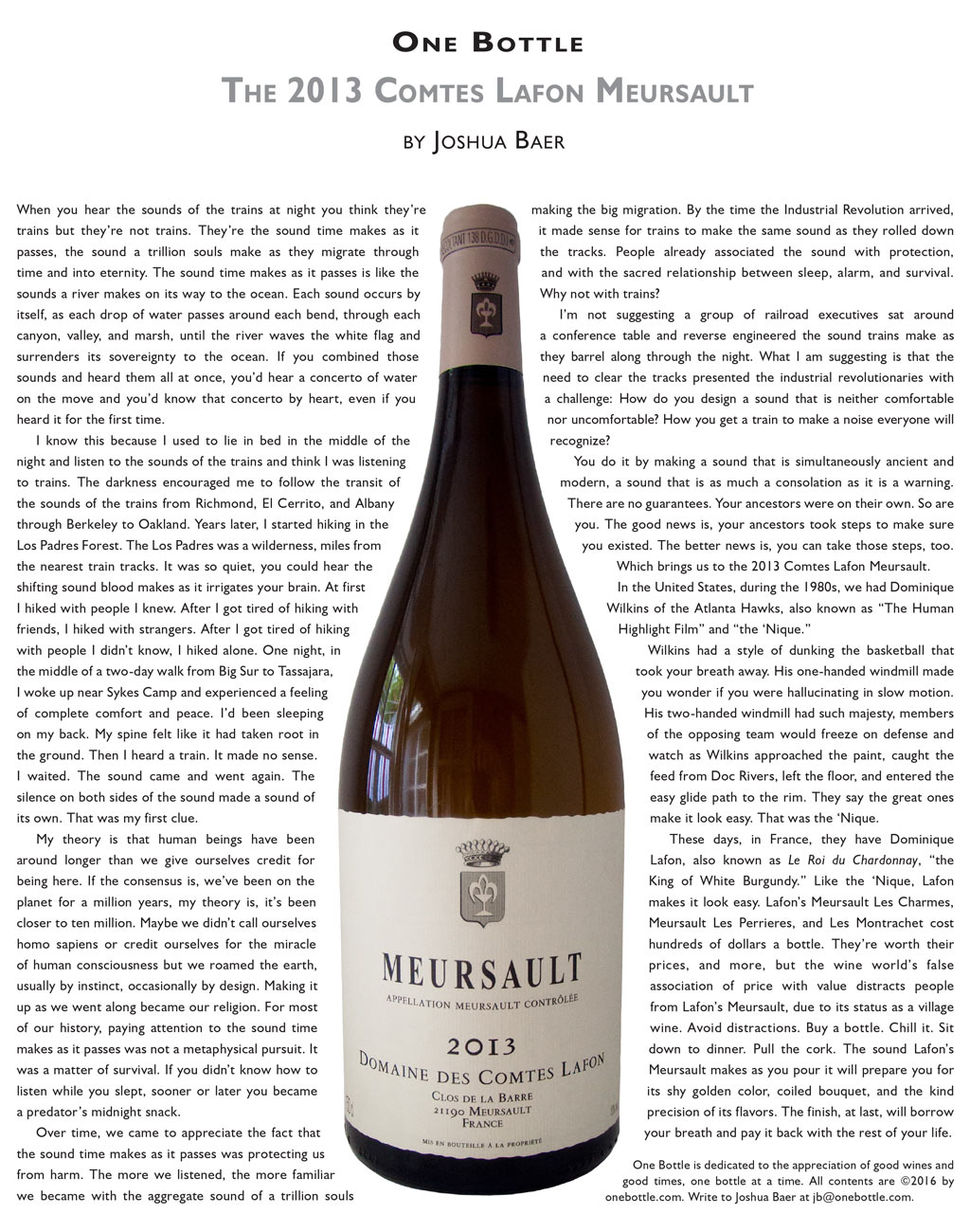2013 Comte Lafon Meursault
When you hear the sounds of the trains at night you think they’re trains but they’re not trains. They’re the sound time makes as it passes, the sound a trillion souls make as they migrate through time and into eternity. The sound time makes as it passes is like the sounds a river makes on its way to the ocean. Each sound occurs by itself, as each drop of water passes around each bend, through each canyon, valley, and marsh, until the river waves the white flag and surrenders its sovereignty to the ocean. If you combined those sounds and heard them all at once, you’d hear a concerto of water on the move and you’d know that concerto by heart, even if you heard it for the first time.
I know this because I used to lie in bed in the middle of the night and listen to the sounds of the trains and think I was listening to trains. The darkness encouraged me to follow the transit of the sounds of the trains from Richmond, El Cerrito, and Albany through Berkeley to Oakland. Years later, I started hiking in the Los Padres Forest. The Los Padres was a wilderness, miles from the nearest train tracks. It was so quiet, you could hear the shifting sound blood makes as it irrigates your brain. At first I hiked with people I knew. After I got tired of hiking with friends, I hiked with strangers. After I got tired of hiking with people I didn’t know, I hiked alone. One night, in the middle of a two-day walk from Big Sur to Tassajara, I woke up near Sykes Camp and experienced a feeling of complete comfort and peace. I’d been sleeping on my back. My spine felt like it had taken root in the ground. Then I heard a train. It made no sense. I waited. The sound came and went again. The silence on both sides of the sound made a sound of its own. That was my first clue.
My theory is that human beings have been around longer than we give ourselves credit for being here. If the consensus is, we’ve been on the planet for a million years, my theory is, it’s been closer to ten million. Maybe we didn’t call ourselves homo sapiens or credit ourselves for the miracle of human consciousness but we roamed the earth, usually by instinct, occasionally by design. Making it up as we went along became our religion. For most of our history, paying attention to the sound time makes as it passes was not a metaphysical pursuit. It was a matter of survival. If you didn’t know how to listen while you slept, sooner or later you became a predator’s midnight snack.
Over time, we came to appreciate the fact that the sound time makes as it passes was protecting us from harm. The more we listened, the more familiar we became with the aggregate sound of a trillion souls making the big migration. By the time the Industrial Revolution arrived, it made sense for trains to make the same sound as they rolled down the tracks. People already associated the sound with protection, and with the sacred relationship between sleep, alarm, and survival. Why not with trains?
I’m not suggesting a group of railroad executives sat around a conference table and reverse engineered the sound trains make as they barrel along through the night. What I am suggesting is that the need to clear the tracks presented the industrial revolutionaries with a challenge: How do you design a sound that is neither comfortable nor uncomfortable? How you get a train to make a noise everyone will recognize?
You do it by making a sound that is simultaneously ancient and modern, a sound that is as much a consolation as it is a warning. There are no guarantees. Your ancestors were on their own. So are you. The good news is, your ancestors took steps to make sure you existed. The better news is, you can take those steps, too.
Which brings us to the 2013 Comtes Lafon Meursault.
In the United States, during the 1980s, we had Dominique Wilkins of the Atlanta Hawks, also known as “The Human Highlight Film” and “the ‘Nique.”
Wilkins had a style of dunking the basketball that took your breath away. His one-handed windmill made you wonder if you were hallucinating in slow motion. His two-handed windmill had such majesty, members of the opposing team would freeze on defense and watch as Wilkins approached the paint, caught the feed from Doc Rivers, left the floor, and entered the easy glide path to the rim. They say the great ones make it look easy. That was the ‘Nique.
These days, in France, they have Dominique Lafon, also known as Le Roi du Chardonnay, “the King of White Burgundy.” Like the ‘Nique, Lafon makes it look easy. Lafon’s Meursault Les Charmes, Meursault Les Perrieres, and Les Montrachet cost hundreds of dollars a bottle. They’re worth their prices, and more, but the wine world’s false association of price with value distracts people from Lafon’s Meursault, due to its status as a village wine. Avoid distractions. Buy a bottle. Chill it. Sit down to dinner. Pull the cork. The sound Lafon’s Meursault makes as you pour it will prepare you for its shy golden color, coiled bouquet, and the kind precision of its flavors. The finish, at last, will borrow your breath and pay it back with the rest of your life.
One Bottle is dedicated to the appreciation of good wines and good times, one bottle at a time. You can write to Joshua Baer at jb@onebottle.com.
